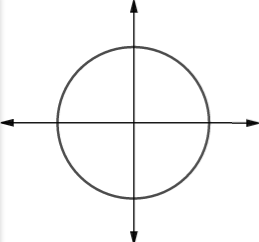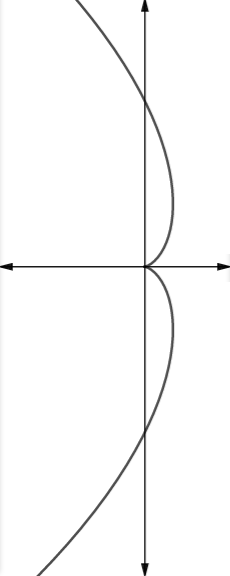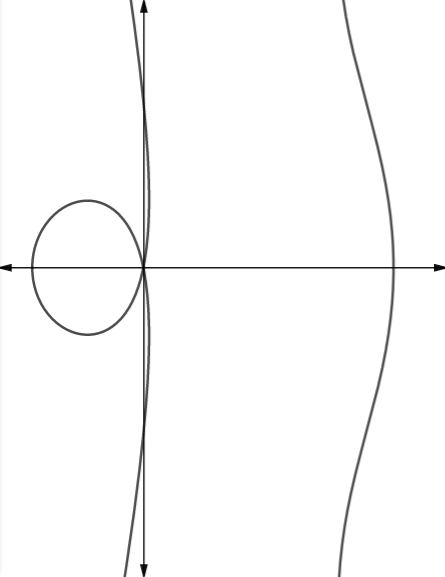
Single Variable Calculus: Concepts and Contexts, Enhanced Edition
4th Edition
ISBN: 9781337687805
Author: James Stewart
Publisher: Cengage Learning
expand_more
expand_more
format_list_bulleted
Question
Chapter H.1, Problem 67E
To determine
To graph: The polar curve
Expert Solution & Answer
Explanation of Solution
Given:
The given polar curve,
Here would be many number of graph because depend on a.
For

This is shape of circle.
For

This is shape of heart.
For

This jelly type structure.
Chapter H.1 Solutions
Single Variable Calculus: Concepts and Contexts, Enhanced Edition
Ch. H.1 - Prob. 1ECh. H.1 - Prob. 2ECh. H.1 - Prob. 3ECh. H.1 - Prob. 4ECh. H.1 - Prob. 5ECh. H.1 - Prob. 6ECh. H.1 - Prob. 7ECh. H.1 - Prob. 8ECh. H.1 - Prob. 9ECh. H.1 - Prob. 10E
Ch. H.1 - Prob. 11ECh. H.1 - Prob. 12ECh. H.1 - Prob. 13ECh. H.1 - Prob. 14ECh. H.1 - Prob. 15ECh. H.1 - Prob. 16ECh. H.1 - Prob. 17ECh. H.1 - Prob. 18ECh. H.1 - Prob. 19ECh. H.1 - Prob. 20ECh. H.1 - Prob. 21ECh. H.1 - Prob. 22ECh. H.1 - Prob. 23ECh. H.1 - Prob. 24ECh. H.1 - Prob. 25ECh. H.1 - Prob. 26ECh. H.1 - Prob. 27ECh. H.1 - Prob. 28ECh. H.1 - Prob. 29ECh. H.1 - Prob. 30ECh. H.1 - Prob. 31ECh. H.1 - Prob. 32ECh. H.1 - Prob. 33ECh. H.1 - Prob. 34ECh. H.1 - Prob. 35ECh. H.1 - Prob. 36ECh. H.1 - Prob. 37ECh. H.1 - Prob. 38ECh. H.1 - Prob. 39ECh. H.1 - Prob. 40ECh. H.1 - Prob. 41ECh. H.1 - Prob. 42ECh. H.1 - Prob. 43ECh. H.1 - Prob. 44ECh. H.1 - Prob. 45ECh. H.1 - Prob. 46ECh. H.1 - Prob. 48ECh. H.1 - Prob. 49ECh. H.1 - Prob. 50ECh. H.1 - Prob. 51ECh. H.1 - Prob. 52ECh. H.1 - Prob. 53ECh. H.1 - Prob. 54ECh. H.1 - Prob. 55ECh. H.1 - Prob. 56ECh. H.1 - Prob. 57ECh. H.1 - Prob. 58ECh. H.1 - Prob. 59ECh. H.1 - Prob. 60ECh. H.1 - Prob. 61ECh. H.1 - Prob. 62ECh. H.1 - Prob. 63ECh. H.1 - Prob. 64ECh. H.1 - Prob. 65ECh. H.1 - Prob. 66ECh. H.1 - Prob. 67ECh. H.1 - Prob. 69ECh. H.1 - Prob. 70E
Knowledge Booster
Learn more about
Need a deep-dive on the concept behind this application? Look no further. Learn more about this topic, calculus and related others by exploring similar questions and additional content below.Similar questions
- 8. For x>_1, the continuous function g is decreasing and positive. A portion of the graph of g is shown above. For n>_1, the nth term of the series summation from n=1 to infinity a_n is defined by a_n=g(n). If intergral 1 to infinity g(x)dx converges to 8, which of the following could be true? A) summation n=1 to infinity a_n = 6. B) summation n=1 to infinity a_n =8. C) summation n=1 to infinity a_n = 10. D) summation n=1 to infinity a_n diverges.arrow_forwardPLEASE SHOW ME THE RIGHT ANSWER/SOLUTION SHOW ME ALL THE NEDDED STEP 13: If the perimeter of a square is shrinking at a rate of 8 inches per second, find the rate at which its area is changing when its area is 25 square inches.arrow_forwardDO NOT GIVE THE WRONG ANSWER SHOW ME ALL THE NEEDED STEPS 11: A rectangle has a base that is growing at a rate of 3 inches per second and a height that is shrinking at a rate of one inch per second. When the base is 12 inches and the height is 5 inches, at what rate is the area of the rectangle changing?arrow_forward
- please answer by showing all the dfalowing necessary step DO NOT GIVE ME THE WRONG ANSWER The sides of a cube of ice are melting at a rate of 1 inch per hour. When its volume is 64 cubic inches, at what rate is its volume changing?arrow_forwardSox & Sin (px) dx 0arrow_forward8 L 8 e ipx dxarrow_forward
- Find the Taylor polynomial T³(×) for the function f centered at the number a. f(x) = xe-2x a = 0 T3(x) =arrow_forwardFor each graph in Figure 16, determine whether f (1) is larger or smaller than the slope of the secant line between x = 1 and x = 1 + h for h > 0. Explain your reasoningarrow_forwardPoints z1 and z2 are shown on the graph.z1 is at (4 real,6 imaginary), z2 is at (-5 real, 2 imaginary)Part A: Identify the points in standard form and find the distance between them.Part B: Give the complex conjugate of z2 and explain how to find it geometrically.Part C: Find z2 − z1 geometrically and explain your steps.arrow_forward
- A polar curve is represented by the equation r1 = 7 + 4cos θ.Part A: What type of limaçon is this curve? Justify your answer using the constants in the equation.Part B: Is the curve symmetrical to the polar axis or the line θ = pi/2 Justify your answer algebraically.Part C: What are the two main differences between the graphs of r1 = 7 + 4cos θ and r2 = 4 + 4cos θ?arrow_forwardA curve, described by x2 + y2 + 8x = 0, has a point A at (−4, 4) on the curve.Part A: What are the polar coordinates of A? Give an exact answer.Part B: What is the polar form of the equation? What type of polar curve is this?Part C: What is the directed distance when Ø = 5pi/6 Give an exact answer.arrow_forwardNew folder 10. Find the area enclosed by the loop of the curve (1- t², t-t³)arrow_forward
arrow_back_ios
SEE MORE QUESTIONS
arrow_forward_ios
Recommended textbooks for you
 Calculus: Early TranscendentalsCalculusISBN:9781285741550Author:James StewartPublisher:Cengage Learning
Calculus: Early TranscendentalsCalculusISBN:9781285741550Author:James StewartPublisher:Cengage Learning Thomas' Calculus (14th Edition)CalculusISBN:9780134438986Author:Joel R. Hass, Christopher E. Heil, Maurice D. WeirPublisher:PEARSON
Thomas' Calculus (14th Edition)CalculusISBN:9780134438986Author:Joel R. Hass, Christopher E. Heil, Maurice D. WeirPublisher:PEARSON Calculus: Early Transcendentals (3rd Edition)CalculusISBN:9780134763644Author:William L. Briggs, Lyle Cochran, Bernard Gillett, Eric SchulzPublisher:PEARSON
Calculus: Early Transcendentals (3rd Edition)CalculusISBN:9780134763644Author:William L. Briggs, Lyle Cochran, Bernard Gillett, Eric SchulzPublisher:PEARSON Calculus: Early TranscendentalsCalculusISBN:9781319050740Author:Jon Rogawski, Colin Adams, Robert FranzosaPublisher:W. H. Freeman
Calculus: Early TranscendentalsCalculusISBN:9781319050740Author:Jon Rogawski, Colin Adams, Robert FranzosaPublisher:W. H. Freeman
 Calculus: Early Transcendental FunctionsCalculusISBN:9781337552516Author:Ron Larson, Bruce H. EdwardsPublisher:Cengage Learning
Calculus: Early Transcendental FunctionsCalculusISBN:9781337552516Author:Ron Larson, Bruce H. EdwardsPublisher:Cengage Learning

Calculus: Early Transcendentals
Calculus
ISBN:9781285741550
Author:James Stewart
Publisher:Cengage Learning

Thomas' Calculus (14th Edition)
Calculus
ISBN:9780134438986
Author:Joel R. Hass, Christopher E. Heil, Maurice D. Weir
Publisher:PEARSON

Calculus: Early Transcendentals (3rd Edition)
Calculus
ISBN:9780134763644
Author:William L. Briggs, Lyle Cochran, Bernard Gillett, Eric Schulz
Publisher:PEARSON

Calculus: Early Transcendentals
Calculus
ISBN:9781319050740
Author:Jon Rogawski, Colin Adams, Robert Franzosa
Publisher:W. H. Freeman


Calculus: Early Transcendental Functions
Calculus
ISBN:9781337552516
Author:Ron Larson, Bruce H. Edwards
Publisher:Cengage Learning
Polar Coordinates Basic Introduction, Conversion to Rectangular, How to Plot Points, Negative R Valu; Author: The Organic Chemistry Tutor;https://www.youtube.com/watch?v=aSdaT62ndYE;License: Standard YouTube License, CC-BY